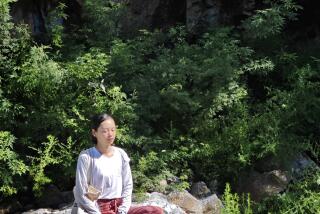‘We’re Fighting Against the Rest of Manhattan’ : N.Y. Chinatown: Victim or Beneficiary of Modern Times?
NEW YORK — Chinatown, bucking the trend, is an ethnic neighborhood that is growing. It’s also becoming gentrified and Westernized, and not everybody is happy about that.
Most of Manhattan’s old ethnic neighborhoods are slowly losing their identity as a result of an exodus to the suburbs, economic redevelopment or a lack of new immigrants.
But each month about 1,500 new residents arrive in Chinatown, located along Canal Street above lower Manhattan. Over the last 15 years, Chinatown’s population has tripled to an estimated 160,000, while the area it occupies has increased from about four square blocks to three square miles.
Some residents, like Charles Lai, a community activist, say that growth is undermining the ties that unite the residents of this historical community.
No Longer Isolated
Skyrocketing land prices are forcing businesses and restaurants to leave the area, fragmenting the community, some say. And the flight of second-generation Chinese from Chinatown is slowly turning the community into an old people’s home, where community organizations and lineage groups supply outmoded services to a changing population.
Others, like Peter Zheng, news editor at the China Daily News, one of 10 newspapers that serve the community, contend that Chinatown and the Chinese are entering the mainstream of American life, no longer isolated by the “Great Wall” of Canal Street.
Chinatown started in the mid-19th Century as a “Bachelor Society” of about 5,000 poor male laborers who spent their days and nights washing clothes, laying bricks, scrubbing dishes, and thinking of their homes in southern China.
The Chinese Exclusion Act of 1882, which prohibited women from immigrating to America, limited the area’s growth. The act was repealed in 1943, and refugees from China’s civil war were allowed into the United States.
By 1960, about 20,000 people lived in Chinatown.
In 1965, the federal government increased from 105 to 20,000 the annual quota of Chinese permitted to immigrate to the United States. The quota was doubled in 1982 to include the newly recognized People’s Republic of China.
Political Unheaval
Political and economic upheaval in Vietnam, Hong Kong, China, Taiwan, the Philippines and Latin America, home to 400,000 ethnic Chinese, continue to add to the boom.
But the real change is in the type of Chinese who are coming to America and Chinatown.
Immigrants in the past came mainly from the countryside and often were illiterate. Over the last 15 years, most of Chinatown’s new residents have come to America with skills, education and capital, said Charles Wang, president of the Chinatown Planning Council, a quasi-governmental agency that administers a variety of social services.
“The old concept about Chinese as laundrymen and waiters is dead,” said Heo-Peh Lee, president of Shi Jie Enterprises, a major New York developer.
“In Hong Kong, all the wealthy people are running away,” said Joseph P.C. Mei, president of the Chinese Consolidated Benevolent Assn. “They’re buying passports and burying their money in the U.S.A.”
Seventeen banks now operate in the area, which used to be served by three. Travel companies compete with vegetable stalls for business space while service industries encroach upon garment factories, which are moving to Brooklyn and Queens.
Tenements that sold for $60,000 in the mid-1960s are now commanding more than $1 million.
But life in Chinatown is losing the community feeling that made it unique, said Margaret Fung, the executive director of the Asian American Legal Defense and Education Fund (AALDEF).
“We’re fighting against the rest of Manhattan,” said Lai, the executive director of the Chinatown Historical Project. “We keep saying that we want to keep our lives here and the culture here.”
The middle- and upper-middle classes who have invested in Chinatown are making it too expensive for its traditional residents, the poor laborers, who, although fewer in number, still make bustling Chinatown their home, Lai and Fung said.
‘Can’t Live Elsewhere’
The AALDEF has sued New York over proposed zoning changes that would allow more luxury housing in the community. One suit charges that the city, by encouraging gentrification in Chinatown, forces lower-income families to flee the area or enter the burgeoning ranks of New York’s homeless.
“It’s pretty clear that people can’t live elsewhere,” Fung said.
There are also tensions between first- and second-generation Chinese, Lai said.
As economic success comes to the sons and daughters of immigrants, they leave Chinatown and move to greener pastures in Brooklyn, Queens and Long Island.
‘Haven’t Found It’
“It seems that in order to make it in America you have to leave your community,” Lai said. “But there has to be a creative way to get the talented to practice their trade and skills within the community. We just haven’t found it.”
Most of the new immigrants who settle in Chinatown come with money and skills, Lai said. “They don’t need the traditional networks to find them a job like the old ones used to.”
As a result, the old business and lineage groups, which used to find housing and jobs for new settlers, have become social clubs where aging Chinese men play Mah-Jongg and read the newspaper.
From the late 19th Century to the 1960s, the lineage groups--made up of people with the same last name or immigrants hailing from the same village--were one of the prime forms of association in Chinese communities overseas.
Groups Lose Importance
The groups served as a buffer to a sometimes hostile foreign world and as an important link between the Chinese and their new surroundings.
Immigrants arriving from small villages would invariably find a relative or a relative’s friend in these groups who would gladly provide information on how to cope with life outside China.
The groups were also an important conduit for information from home, as new immigrants came in with the latest news on weddings, births, local politics and crop conditions.
But now immigrants get the news from newspapers, their jobs from professional services and their housing from want ads.
Just a Tourist Attraction
“The groups still serve a function but they are outdated,” Lai said.
Lai and Fung predict that one day Chinatown will be just a tourist attraction, devoid of community ties and neighborhood organizations and inhabited by Chinese-Americans who have forgotten their past.
Developers, like Lee, scoff at the worries of Lai and Fung who represent what Lee called “the intellectuals of Chinatown.”
“Chinatown is a community not only for the illiterate and hard laborers, but for everybody,” Lee said. “There might be some injustices here, but that’s part of the process.”
‘Want to Get Best People’
Upper-income families moving into Chinatown will help, not hurt, the community because they will spend money there, Lee said.
“We want to make Chinatown prosperous so we want to get the best people moving in,” Lee said. “Why do you want people with no ability to pay moving into the area?”
Lee said the breakdown of Chinatown’s community groups is welcome evidence that Chinatown is moving “day by day, minute by minute, into the mainstream of American life.”
“The Chinese won’t be able to hide behind their family groups anymore,” said Zheng, of the China Daily News. “Chinatown is shedding its image. It will become more aggressive and open.”
“The intellectuals are living in the past,” Lee said. “They are nostalgic for a Chinatown of 50 years ago.”
“Like a boat against the current,” he said, invoking an old Chinese expression, “if you don’t go forward, then you’re going back.”
More to Read
Sign up for Essential California
The most important California stories and recommendations in your inbox every morning.
You may occasionally receive promotional content from the Los Angeles Times.










